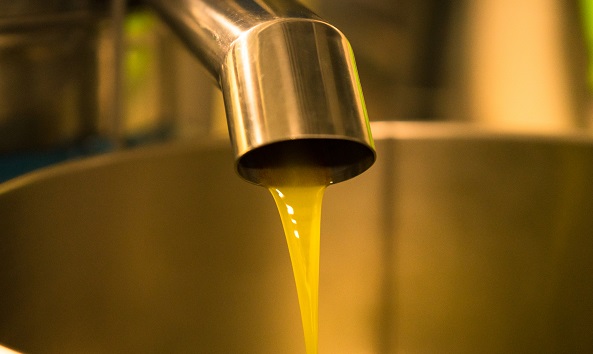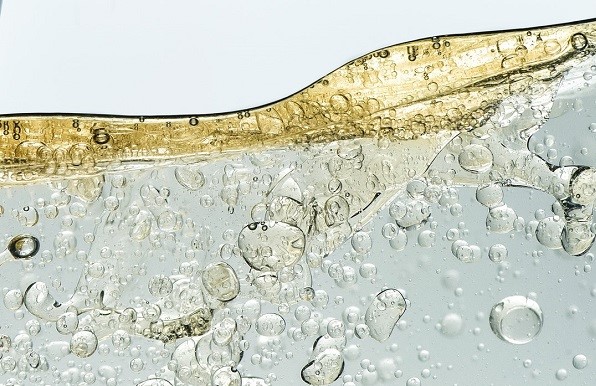The refining of wool grease obtained from sheep’s wool is essential for the production of lanolin. Depending on factors such as sheep breed, season, and wool quality, wool grease typically accounts for approximately 10-15% of the weight of the shorn fleece. After shearing a sheep, the fleece undergoes a vital cleansing process known as scouring and the wool grease is extracted through high-speed centrifugation. Before centrifugation, heavy impurities such as sand and dirt are eliminated through gravity settlement. To further minimise impurities like sweat or environmental contaminants, the initial wool grease concentrate is emulsified in hot water and subjected to a second round of centrifugation. The resulting substance serves as the starting material for the production of lanolin, the most commonly derived product from wool grease.
In order to enhance the efficiency of the initial centrifugation and facilitate the separation of liquid and hydrophobic wax, some scouring solutions may incorporate specific acids. These acids promote a chemical breakdown of the soap that stabilises the wax emulsion. However, modern processing plants often omit this step due to the release of free fatty acids, which results in wool grease products with high acid values.
Although only 50% of the available wool grease can be recovered through the centrifugation process, the lower yield is compensated by the superior quality of the obtained raw material. In addition to the conventional centrifugal technique, alternative methods can be used to recover wool grease. If the grease is, for example, directly extracted from the wool using organic solvents, the yield is generally higher, and it safeguards the fleece from potentially adverse alkaline treatments.

The harvested wool grease is a dark, highly viscous, and greasy paste. In this raw form, it can be utilised in various technical applications. However, due to its colour, distinctive odour, and significant amount of impurities present at this stage, further refinement is necessary before it can be used in cosmetic products and the pharmaceutical industry.

Techniques and materials used during the production of lanolin and refinement can vary. Generally, the initial step involves breaking up soaps and eliminating impurities. Afterwards the free fatty acids in the wax undergo neutralisation through an alkaline treatment. The resulting soaps can be extracted using ethanol or isopropanol mixed with water to ensure the removal of undesired substances from the mixture.
Depending on the desired level of purity, the extraction procedure can be repeated using more concentrated alcohol mixtures. Additional reduction of contaminants can be accomplished by treating the wax with adsorbents followed by filtration. To eliminate residual pesticides and odours, the wool grease undergoes high vacuum exposure while being simultaneously heated. This also reduces the quantity of free lanolin alcohols. By adjusting the vacuum and temperature conditions, their content can be lowered to below 3% by weight, which is essential for ensuring hypoallergenic properties in the final product.
During this stage of the refinement process, the majority of impurities, including free fatty acids, detergents, and pesticides, are significantly reduced, resulting in a pleasant deodorised product. The initially dark colour of the lanolin transforms into a pale yellow shade. While the colour itself does not impact the quality of the refined lanolin, certain cosmetic applications require a brighter appearance. Therefore, lanolin production can entail the bleaching of the wax using common oxidative reagents, such as hydrogen peroxide (found in hair bleaching products), sodium hypochlorite, sodium perborate, or other inorganic materials.
However, if hydrogen peroxide is used, it may lead to the formation of unwanted organic peroxide derivatives of wax esters, necessitating additional treatment for their removal. If the lanolin is left unbleached, small concentrations of approved antioxidants, like butylated hydroxytoluene (BHT), are typically added at the end of the refinement process. This helps to prevent surface degradation caused by autoxidation by limiting air exposure.
In the last phase of refinement, residual water is eliminated from the lanolin through a vacuum-drying process, resulting in a pale ointment-like substance. This refined lanolin possesses a barely noticeable odour. It exhibits solubility in organic solvents such as diethyl ether, chloroform, and chloroform/methanol mixtures. However, it shows poor solubility in ethanol. Notably, refined lanolin does not dissolve in water, but it can be mixed with water to form stable water-in-oil (w/o) emulsions.
Component
Crude centrifugal wool grease
Refined pharmaceutical lanolin
Water
Crude centrifugal wool grease:
1-5% w/w
Refined pharmaceutical lanolin:
0.05% w/w
Free fatty acids
Crude centrifugal wool grease:
1-8% w/w
Refined pharmaceutical lanolin:
0.30% w/w
Free fatty alcohols
Crude centrifugal wool grease:
6-12% w/w
Refined pharmaceutical lanolin:
2.50% w/w
Wax esters
Crude centrifugal wool grease:
75-90% w/w
Refined pharmaceutical lanolin:
97.0% w/w
Water soluble salts of potassium and sodium
Crude centrifugal wool grease:
0.1-0.2 w/w
Refined pharmaceutical lanolin:
not quantified
Lipid soluble salts of calcium, magnesium, iron, aluminium
Crude centrifugal wool grease:
0.2-2.0 w/w
Refined pharmaceutical lanolin:
not quantified
Detergent residues
Crude centrifugal wool grease:
0.1-1.0 w/w
Refined pharmaceutical lanolin:
0.02% w/w
Pesticide residues
Crude centrifugal wool grease:
20-150 mg kg-1
Refined pharmaceutical lanolin:
0.8 mg kg-1
Polyaromatic hydrocarbons
Crude centrifugal wool grease:
0.1-0.5 mg kg-1
Refined pharmaceutical lanolin:
0.08 µg kg-1
Particulate insoluble matters
Crude centrifugal wool grease:
0.1-2.0
Refined pharmaceutical lanolin:
not quantified
Peroxide value
Crude centrifugal wool grease:
not quantified
Refined pharmaceutical lanolin:
12.0 meq. kg-1
Colour
Crude centrifugal wool grease:
dark brown
Refined pharmaceutical lanolin:
pale to yellow
Odour
Crude centrifugal wool grease:
peculiar smell
Refined pharmaceutical lanolin:
almost odorless
Source: E.W. Clark 1999, ‘The History and Evolution of Lanolin’

Chris Kommerowski
Sales Director
Chris Kommerowski Sales Director
Marco Heins Product Manager
Kruna Ramljak Product Manager
Christina Wegener Logistics & Sales Manager
Petra Pingel Logistics Manager
Julian Gruß Logistics Manager